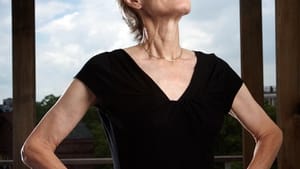Stay in the Loop
BSR publishes on a weekly schedule, with an email newsletter every Wednesday and Thursday morning. There’s no paywall, and subscribing is always free.
Lucinda Childs, body and soul
Lucinda Childs: Origins of post-modern dance

In this historic presentation of reconstructed dances, some of the best of Philadelphia’s modern dancers tackled the challenging work of Lucinda Childs, a pioneer of post-modern dance in America. According to Childs, who might be best known to a larger public as the lead dancer in her collaboration with Philip Glass and Robert Wilson in Einstein on the Beach (1976), this was the first time in her half-century of choreography that she presented entire programs of her early work, from 1963 to 1978.
The emergence of post-modern dance, defined by its origins at the Judson Dance Theater (co-founded by Childs), has entered the contemporary <i>zeitgeis</i>t and thrust Childs into broader view. This renewed interest may be seen in the passionate embrace of Judson works by Mikhail Baryshnikov and in art museum presentations, including the Philadelphia Museum of Art’s Merce Cunningham dance series and the Whitney Museum’s showing of early Trisha Brown.
Childs’s own 1979 breakthrough masterpiece, Dance (with music by Glass and film design by Sol LeWitt), was itself reconstructed and presented in Philadelphia’s 2010 Live Arts Festival.
Beyond Isadora and Martha
The three Childs works from the 1960s reveal her radical departure from the modern dance tradition that stretched from Isadora Duncan to Martha Graham, and that had become laden with formulaic expressiveness and theatrical conventions. These pieces, as well as Childs’s subsequent work, reveal that inspired innovation can also include a respectful recasting of classical and formal elements of the dance of her predecessors.
In Pastime (1963), the first solo she created, she sought “to break from the traditional theme-and-variation orientation in choreographic structure.” Here Childs concentrates on the reductively simple element of a flexed foot— standing, sheathed in a cloth tube, and upside down. As with many minimalist conceits, this focuses the audience’s gaze and allows the eye to discover subtleties of body and movement.
In Pastime’s middle section, the performer (Gabrielle Revlock and Janet Pilla in separate renditions) sits within a grey elastic jersey, bracing herself with locked knees and flexed feet. It’s a stunning image, calling to mind a cocoon, or pod or boat. We hear the sound of water as if rushing through archaic plumbing.
If one conjures the image of the biomorphic shroud that embodied the angst of Martha Graham’s <i>Lamentation</i> (1930), Childs’s tubular cloth surround, in contrast, is totally drained of emotion or narrative except the dash of irony suggested by Revlock’s and Pilla’s vigilantly fixed stares into the audience.
Zany imagination
Museum Piece (1965) is more like performance art than a choreographed dance; it deconstructs and transforms Georges Seurat’s <i>Le Cirque </i>into a color field playground. The soloist (Megan Bridge and Annie Wilson, in separate performances) tosses onto the stage colored circles representing the painting’s pointillist dots as she speaks to us about seeing the work; she, however, only views the circles by reflection in a mirror that she holds, as she gingerly walks backwards among the dots.
Although the text refers to the luminosity of the post-impressionist method, the piece itself is more about the luminosity of Childs’s zany imagination.
Out on Broad Street
Years before the term “site specific” came into use, Childs created Street Dance (1964). Astonishingly, it has been performed only twice before, at the studio of Robert and Judith Dunn in New York and a year later at Robert Rauschenberg’s loft. For the Philadelphia re-creation, we gathered at the Broad-Street-facing windows in a UArts dance studio, to watch the street below.
A pre-recorded narration alerted us to the presence of two dancers (Pilla and Michelle Tantoco in one performance, Nora Gibson and Revlock in the other) in front of the Wells Fargo Bank building; the narration tracked their ecstatic discoveries of sidewalk signage and building facade ornament— obscured to us in our second floor view across Broad Street.
In this interposition of art with material life, we were reminded of Childs’s take on Judson as showing us that “nothing is necessarily extraneous to dance.” Adding the unique wonderment of site-specific’s unexpected, gaping tourists on the top deck of a tour bus stopped before us on Broad Street, oblivious to the duo across the street and their own role in <i>Street Dance</i>.
Endless possibilities
Ever the curious radical, Childs made her signature departure from Judson, as shown in the other dances of the ’70s on these two programs. All are striking and appealing in their melding of a formal rigor with a sensuous serenity.
Childs’s esthetic— that the content is the form— is fully in synch with her contemporary post-modernists of the visual arts (like Donald Judd and Sol LeWitt) and of music (Philip Glass and Steve Reich). And although the shorthand of minimalism is often used to describe this art (often to the artists’ chagrin), Childs, when describing the influence of LeWitt on her work, emphasizes that out of limited or reduced movements or phrases can emerge almost endless possibilities.
In Katema (1978), originally a Childs solo re-created for the first time as a quartet here, two pairs of dancers (Gibson, Revlock, Tantoco, Wilson, and Pilla in another version) created a rhythmic geometry of identical walks and pivot turns on a diagonal, with their swinging arms offering a relaxed and buoyant air to the reduced precision movement.
Endurance test
Melody Excerpt (1977) is a tour de force of concentration, stamina and collective unity of five dancers (Bridge, Gibson, Pilla, Tantoco and Wilson) who execute— with skips, hops and turns— patterns in space that are at times mystifying in their complexities. Bridge has written that this work unfolds into 1,670 counts, describing it as “more in the realm of endurance art.” The music in this work, as in the others of this period, is found in the rhythms of the body and the soft percussion of feet on floor.
The dancers also provide the driving pulse to <i>Interior Drama</i> (1977), where— in another amazing feat of concentration and immersion in the form— five dancers (Bridge, Gibson, Revlock, Tantoco and Wilson) repeat three slightly varying 160-count phrases.
When you realize that most of these dancers had worked on and off for close to three years with Childs to re-create such exacting and uplifting work, you can understand how much this art is about the practice and the performing artist’s body-and-soul commitment to the work.
What, When, Where
“Lucinda Childs: Selected Dances, 1963-1976." Reconstructed by Childs with Ty Boomershine. Oct. 4- 6, 2013, at 140 N.Columbus Blvd. and University of the Arts, School of Dance, 1401 Walnut St., 2nd floor.
Sign up for our newsletter
All of the week's new articles, all in one place. Sign up for the free weekly BSR newsletters, and don't miss a conversation.

 Jonathan M. Stein
Jonathan M. Stein